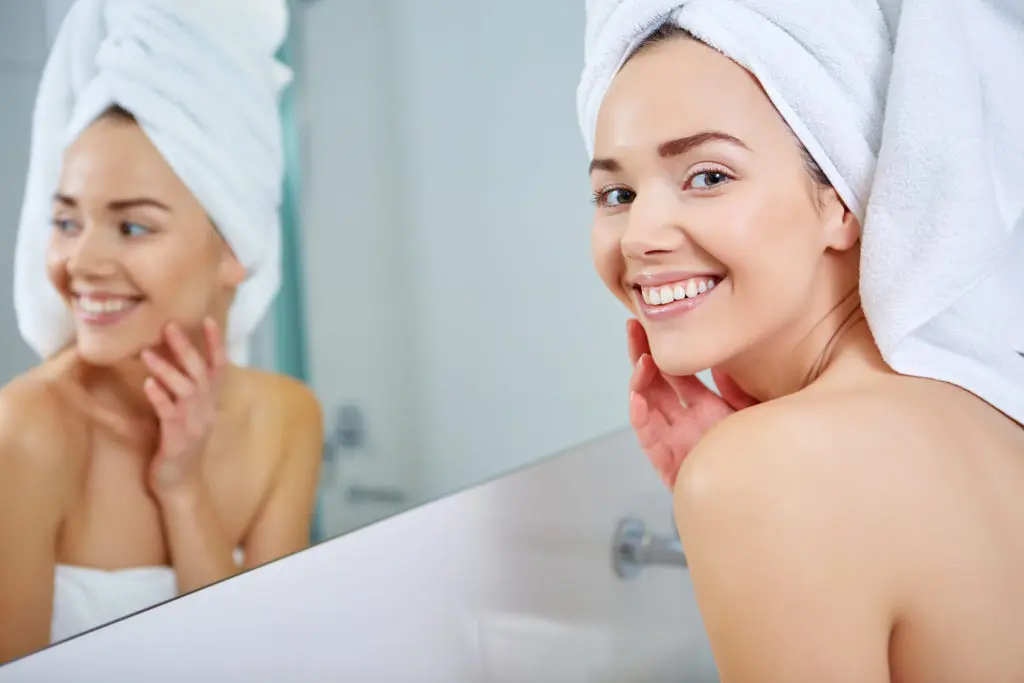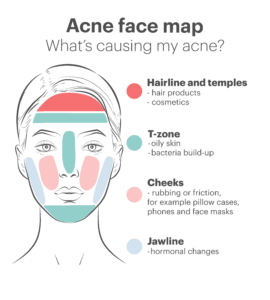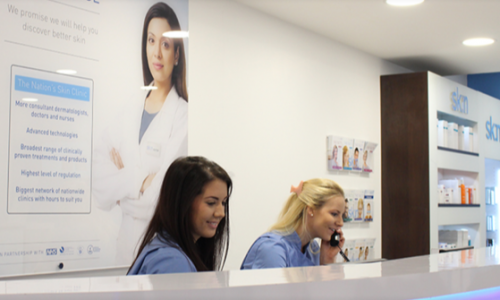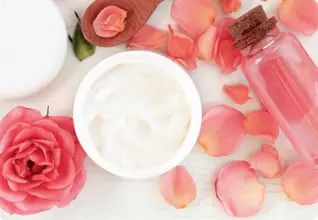Use our acne face map to find out what type of breakout you’ve got

Medically Reviewed June 2023, by Daron Seukeran, Group Medical Director, for sk:n. Next review due June 2024.
New research suggests that the location of your facial acne can be related to external and internal influences. By using our acne face map, it can help identify the cause of your acne and prevent the future recurrence of it.
What is acne?
Acne is a skin condition characterised by abnormal sebum (oil) production. It is often triggered by hormone fluctuations where a group of hormones called androgens, such as testosterone and androstenedione, cause the sebaceous glands to become overactive and sensitive.
The overproduction of oil enables the usually harmless bacteria, p.acnes, to become more aggressive and cause inflammation. The build-up of excess oil and dead skin cells clog the pores and cause the symptoms experienced during an acne flare.
Use the information below to pinpoint where your acne spots usually appear and read further advice on how to manage it.
Hairline and temples
If you’re experiencing any hairline and temple acne that won’t go away, it may be due to the application of cosmetics, such as skin care, hair products, and rubbing of hats, helmets and restrictive headbands.
When acne on temples and hairline is caused by hair products, it is called pomade acne or acne cosmetica. Pomade is a greasy, waxy, or oil-based substance, such as silicone and petrolatum, used in hair products that gives the hair it’s hold, shine and shape-ability.
If you’re already prone to acne, the additional oily ingredients found in hair products and gels causes further blockage of the pores. To minimise the presence of acne in this specific area, incorporate sensitive hair care formulas, ones that are oil-free and noncomedogenic (which do not clog pores).
Ingredients to avoid are oil, petrolatum, acrylates, panthenol, silicone and quaternium-70. Instead, seek organic, more natural ingredients with similar capabilities such as honey, beeswax, sea salt, argan and shea to help style your hair.
If you notice a correlation between headwear and your acne, this type of acne is called acne mechanica. It is common in athletes and is triggered by excess heat and sweat build-up, where the friction of the skin is due to the frequent wearing of hats, helmets and headbands.
A few ways to minimise acne mechanica is to regularly clean any headwear and avoid touching the affected area. The good news about acne mechanica is that it is not considered a chronic form of acne and should diminish when the skin no longer experiences friction.
With most cases of acne, effective treatment involves using skincare products with a higher concentration of salicylic acid or benzoyl peroxide, which have high anti-bacterial and exfoliating properties. These can be prescribed by a doctor or found in a pharmacy.
T-zone (forehead acne, nose and chin acne)
The T-zone, named after the shape of the afflicted areas, covers the forehead, nose and chin regions. Breakouts are common in these areas due to the amount of sebaceous glands found across it.
Whilst there is research that suggests the acne found on the forehead, chin and nose can be exacerbated by lack of sleep and stress, it mostly occurs because of the build-up of bacteria, oil and dead skill cells. These parts of the face are frequently touched, which facilitates the spreading of debris directly to the pores.
To prevent aggravating oily skin, tailoring your skincare regime to include benzoyl peroxide is a first, and using an oil-regulating toner/cleanser containing retinol or niacinamide, a second.
Retinol is a derivative of vitamin A and works to exfoliate and increase cell turnover to reveal a smoother complexion. Unlike other ingredients, topical retinoids are prescribed to effectively treat acne and act by penetrating the epidermis layer of the skin, where they tackle inflammation and control acne outbreaks.
Niacinamide is a form of vitamin B3 which helps to balance oil production, shrink pores and manage acne and rosacea. Acne rosacea is another kind of acne with the primary symptom experienced being excessive redness and swelling. This type of acne is common across the nose, causing the blood vessels to become enlarged and in turn, more visible.
The chin is another common place for acne flares. One cause of chin acne may be due to hormones. Spots are common among females who are menstruating, pregnant or entering the menopause.
Oral contraceptives have shown encouraging evidence in helping to suppress sebum production in hormonal acne and can be prescribed by your doctor if you have persistent acne problems. If you prefer a natural approach, we have evaluated the efficacy of home remedies as a method of controlling acne symptoms.
Cheeks
Acne on cheeks and acne around the mouth can be aggravated by friction and bacteria. Frequently touching the face, whether this is with your hands or with objects – such as mobiles, makeup brushes, pillowcases or facemasks – can act as vehicles for gathering germs, which can take the form of acne-causing bacteria.
By becoming more aware of the role bacteria plays in acne and how it may lead to breakouts, being vigilant on hygiene can help reduce spots.
Some tips are:
- Regularly clean your phone screen
- Wash your face with a gentle, cleansing exfoliant
- Only touch your face with clean hands
- Change your pillowcases weekly
- Wash make-up brushes frequently
- Wear loose, breathable medical face masks rather than tighter, fashionable ones to prevent maskne
Jawline
Similarly to chin acne, spots around the jawline can occur due to hormonal acne. Diet (although not a direct cause of acne) may also influence pre-existing acne.
As acne is a hormonal skin condition, certain foods can create fluctuations in the digestive system which then may lead to sudden shifts in hormones. This triggers an overactivity in the sebaceous glands, making them more sensitive and prompting them to overcompensate by depositing excess oil through the skin glands.
If you notice a correlation between changes in your diet and acne severity, try temporarily avoiding those foods to see if your acne improves. If your acne doesn’t improve after having tried various diets, clinical ointments, medications and hygiene rules, a professional acne treatment may be for you.
Key takeaways
- Hairline and temple acne can be caused by cosmetics, known as acne cosmetica
- T-zone acne can be reduced by incorporating oil-regulating skincare products into your regime
- Chin and jawline acne is often associated with hormones imbalances
- Cheek acne can be caused by friction and can sometimes be acne rosacea rather than normal acne
Need help?
At sk:n, we have a range of treatments that have shown significant results in the reduction and management of acne, from chemical peels and HydraFacial to blue light treatment and laser peels.
Book a consultation with one of our experts, and get tailored advice on how to live without acne constantly impacting your life.
Related Articles

08
Apr 2024

08
Apr 2024
Request a callback
One of our friendly sk:n advisors will call you to book your consultation.
- More than 450 consultants, doctors, nurses and medical practitioners
- Regulated by the Care Quality Commission, Health Inspectorate Wales and Health Improvement Scotland
- Partner of the NHS
- Rated excellent by our clients on Trustpilot
- Strict safety and care protocols





